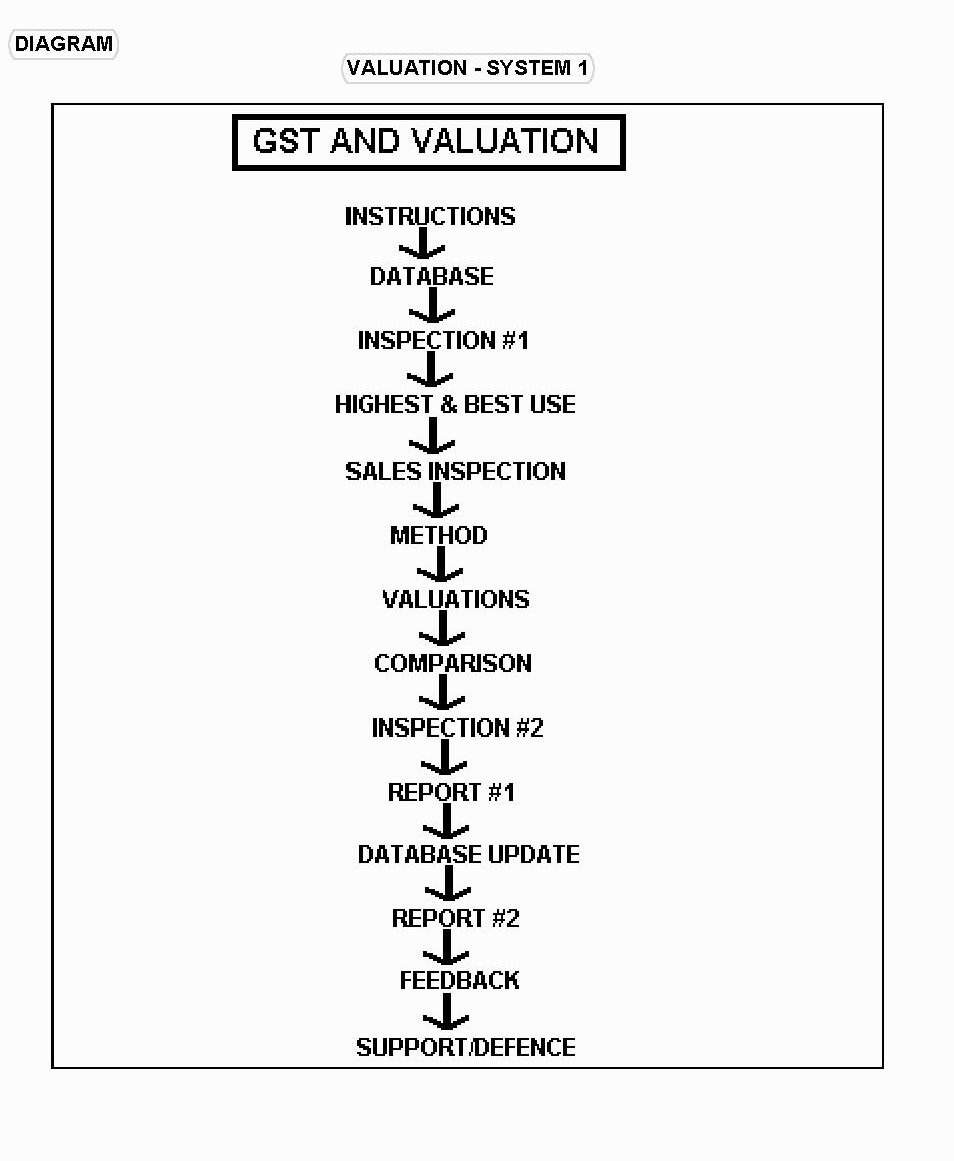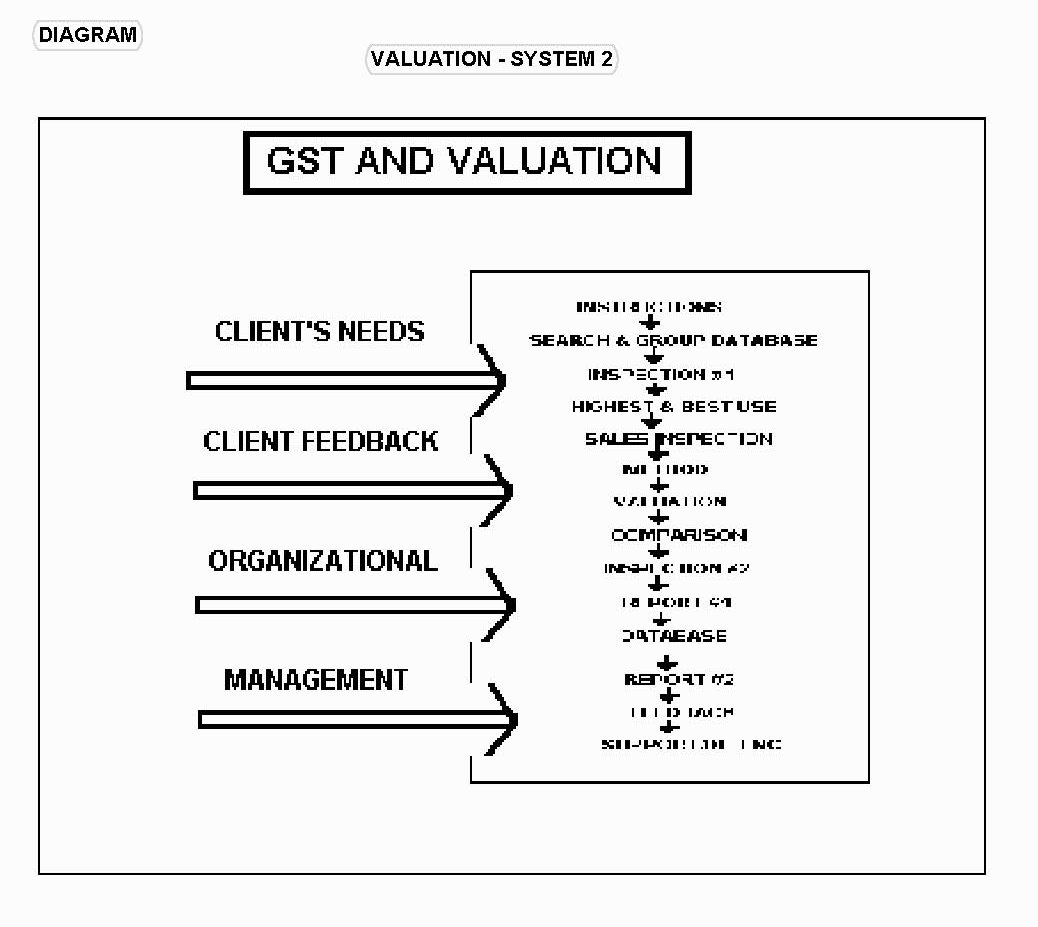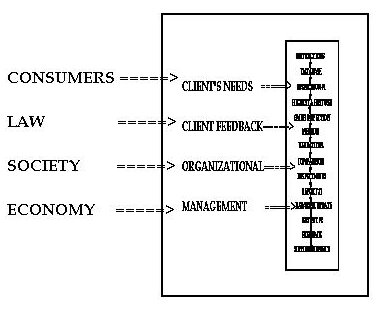GENERAL
SYSTEM THEORY (GST) AND VALUATION
david hornby MEA Llb FAPI
Traditional scientific theory has been modified and enriched by
knowledge from a variety of underlying disciplines. General Systems
Theory (GST) offers the opportunity of synthesis in scientific research
and theory and allows us to view the total subject of study. For
example, a valuation system including its interaction with its many
environments and recognition of the relevant subsystems.
A SYSTEM is
an organised unitary whole but composed of two or more interdependent
parts or subsystems with identifiable boundaries from its environmental
suprasystem. Therefore, what is generally thought of as the valuation
process, is in reality only a subsystem. This is shown in the diagram
below shows the environments for a valuation. GST goes further,
providing a basic frame of reference for the development of a total
valuation system and therefore, helps the valuer to understand the "big
picture". GST and its basic
concepts were pioneered by the biologist, Ludwig von Bertalanffy
(1950).
The biology analogy is most useful for the complex economic, financial,
social, mercantile and legal system which is valuation. The valuation
process can be compared with an organism as it is a system of mutually
dependent parts, each of which includes many subsystems. The starting
point of GST is the important distinction between closed and open
systems.
CLOSED SYSTEMS
A number of physical and mechanical systems can be considered as
"closed" in relationship to their environment. That is, there is very
little intercourse between the system and it's outside environment. A
closed system is inefficient and will eventually "die". For example, a
shopping centre that ignores changing demographic factors within it's
trade area or what it's competitors are doing.
OPEN SYSTEMS
Unlike a closed
system, the valuation process is in constant interaction with its
environment and is therefore, an open system. Too many commentators in
valuation fail to recognise this. For example, what may appear to be a
brilliant valuation method in the cloistered atmosphere of academia may
prove to be completely useless in the "real" world of valuation. The
concept of open or closed is a matter of degree and in an absolute
sense, all systems are open or closed, depending on the point of
reference. All systems are "closed" to some degree from external forces
for example, the valuer generally does not reveal ALL his workings in
the valuation report. GST allows better
understanding and integration of knowledge from a wide range of
specialized fields or disciplines. In the valuation process these
include:
- economics
- social (values)
- legal
- financial
- science and
technology.
The social nature of
the valuation process should not be underestimated for example, writers
such as Talcott Parsons have used the systems approach to effectively
analyze and understand society. Parson's method can also be used to
analyze and understand buyers and sellers in real estate market
transactions (1951).
Economists have also
used the systems approach for example, with equilibrium concepts which
are fundamental in economic thought, and the very basis of this type of
analysis is the consideration of subsystems of a total system.
Economics is moving away from static equilibrium models appropriate to
closed systems toward dynamic equilibrium considerations appropriate to
open systems.
HOLISM
Holism is the view that all systems are composed of interrelated
subsystems. The whole is not just the sum of the parts, but the system
itself can only be explained as a totality. This concept applies to the
valuation process. For example, the "identification of land" system
(the starting point for the valuation process) consists of surveying,
land titles, plans, maps, curtilages, fencelines subsystems.
KEY CONCEPTS OF GST AND VALUATION
BOUNDARIES
The closed system has rigid, impenetrable boundaries whereas the open
system has permeable boundaries between itself and the outside
environment. Boundaries set the "domain" of the organization's
activities. The valuation process has been largely thought of as a
closed system similar to that in diagram one. That is, valuation has
been largely seen from the perspective of the valuer, "downplaying" the
effect of the other environments and systems in the process. However
this is not the case. Rather, valuation is a mix of largely, economics,
law, politics and values. The boundaries are not easily defined and are
determined primarily by the functions and uses of the valuation. The valuation system
should be seen within the context of broader perspectives including the
needs of clients and organizational factors.
The process is better illustrated by the second diagram below where the
valuer's perspective has been reduced to "system one" and is subject to
the outside perspectives and environments in "system 2". For example,
the type of valuation report is determined largely by the needs of the
client. If the client is part of the private sector and requires a
valuation report for an application for mortgage funding then the
valuation firm will respond with a speaking (full) report. On the other
hand if the client is within the same organization, a brief one page
statement of value may be sufficient. There is a tendency
for complex organizations to achieve greater differentiation and
specialization among internal subsystems. For example, in a large
valuation firm, specializations appear such as industrial or commercial
departments.

SUBSYSTEMS OR
COMPONENTS
A system by
definition is composed of interrelated parts or elements. This is true
for all systems are composed of interrelated parts or at least two
elements, and these elements are interconnected. Systems exchange
information, energy, or material with their environments. the more open
the system, the greater is such exchange. Feedback from the valuation
client is most important in the valuation system.

The concept of
feedback is important in understanding how a system maintains a steady
state. Information concerning the outputs or the process of the system
is fed back as and if there is deviation from a prescribed course, the
system then readjusts to a new steady state. For example, a valuation
firm may adjust the wording of valuation disclaimers following the
result of a recent court decision. Interaction with the environment
goes further than that shown in the diagram below.
Law, society
(values), science and economics are all powerful environments which cut
across subsystem two.
The outside
environment shown in the last diagram is most important. For example,
social values require that a good property tax system is one that is
easily understood by the consumer (the taxpayer) and that there is an
effective appeal process subject to the decision making environment of
the courts. This is why property taxes cannot be wholly replaced by
indices or some proxy to market value derived by computer.
As the legal
environment is the final and ultimate umpire, their rules cannot be
ignored. The valuer must be able to prove his/her valuation in court.
That is why the valuer cannot be replaced by the computer and why
research tools such as multiple regression analysis (MRA) can never
become anything more than a support or secondary method of valuation.
Society, consumers, clients and the courts will not allow it as a
primary method of valuation.

Once the "big
picture" provided by GST is appreciated it can be seen that in many
valuation processes the "tail wags the dog". For example, the consumer
of a property tax valuation demands certain valuation criteria which
the law and governments try to provide. For example, a circuit breaker
that provides relief to certain groups seen to be subject to property
taxes that are too high.
The extended
valuation system shown in the diagram below can be further extended.
For example, international law is playing an increasingly important
role in the maintenance of the environment and a large amount of
Federal jurisdiction in land management is achieved through the signing
of international treaties.
With better and better communications
certain world systems will have a greater bearing on the Australian
valuation system.
LEGAL CONTROLS
All states and
territories except South Australia and the ACT have legislation
controlling the activities of real estate valuers particularly by way
of licensing.

7




